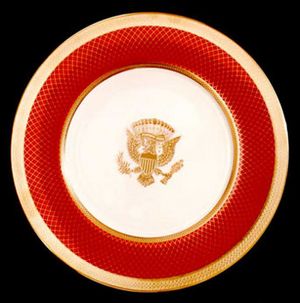Bone china facts for kids
Bone china is a special type of pottery that looks very white and lets light shine through it. It's known for being super strong, even though it can be made very thin. Imagine a teacup that feels light and delicate but is actually quite tough!
This unique material gets its name because it's made using a special ingredient: bone ash. This is mixed with other natural materials like kaolin (a type of clay) and a material similar to feldspar.
People in England first started making bone china in the mid-1700s. They were trying to create porcelain as strong and beautiful as the kind made in Asia. A potter named Josiah Spode in the 1790s really perfected the recipe. His method became so popular that many other factories in England started using it.
For a long time, bone china was mostly made in England, especially in a town called Stoke-on-Trent. Famous companies like Spode, Wedgwood, and Royal Doulton have made it for centuries. Today, bone china is made in many countries around the world, with China being the biggest producer.
Contents
The Story of Bone China
Early Discoveries in England
The idea for bone china started in England. A man named Thomas Frye began experimenting with it in 1748. He had a factory in London and found that adding bone ash to his pottery mix made it stronger and more beautiful. He called his creation "fine porcelain."
Josiah Spode's Big Improvement
About 40 years later, another clever potter named Josiah Spode in Stoke-on-Trent made bone china even better. Between 1789 and 1793, he worked on his own recipe. In 1796, he introduced his new pottery, which he called "Stoke China."
Sadly, Josiah Spode passed away soon after. But his son, Josiah Spode II, continued his work. He renamed the pottery "bone china," and the name stuck! Spode's special recipe, which used specific amounts of bone ash, china stone, and kaolin, became the standard for making bone china. This recipe is still used today!

Bone china quickly became very popular. Its strength and beautiful look made it a favorite for fancy dishes and decorative items. Many other pottery makers in England started making it too.
How Bone China is Made
What Goes Into It?
Making bone china involves a special mix of ingredients. The traditional recipe uses:
- About 50% bone ash
- About 25% kaolin (a type of white clay)
- About 25% China stone (a type of rock)
From Bones to Beautiful Dishes
The bone ash comes from animal bones, usually from cattle. These bones are first cleaned and then heated to a very high temperature, about 1,000 degrees Celsius (1,832 degrees Fahrenheit). This process, called calcination, turns them into a fine, white ash. This ash is then ground into a super fine powder.
The kaolin clay is important because it helps the mixture become soft and moldable. This allows potters to shape the dishes, cups, and other items before they are baked.
Once everything is mixed and shaped, the items are fired in a very hot oven, called a kiln, at about 1,200 degrees Celsius (2,192 degrees Fahrenheit). This high heat makes the material strong and translucent.
Because the ingredients are special and the process takes a lot of careful work, bone china is often more expensive than other types of pottery. It's considered a luxury item!
Modern Alternatives
Since the 1990s, some manufacturers have started using materials from rocks that are similar to bone ash. These materials, called hydroxyapatite compounds, can create bone china that looks and feels just like the traditional kind, but without using animal bones.
Where is Bone China Made?
For nearly 200 years, most bone china was made only in the UK. Other countries that already made porcelain didn't really focus on bone china.
But in the mid-1900s, other countries started making it. Companies in Japan, like Noritake, were among the first outside the UK to succeed.
In the United States, Lenox was a well-known maker of bone china. They even made special dinner sets for the White House! Their factory closed in March 2020.
Today, China is the biggest producer of bone china in the world. You can also find bone china being made in countries like Bangladesh, India, Indonesia, Sri Lanka, and Thailand.
Bone China and Different Choices
Because bone china is made using animal bones, some people might choose not to use it. For example, some people follow specific cultural or religious guidelines about what they can use. Others, like vegetarians and vegans, might avoid products made from animals.
To offer choices for everyone, some companies now make bone china using bones from animals that meet certain cultural standards. Also, there's a type of porcelain called vegan porcelain. This is made without any animal bones at all, using the rock-based materials we talked about earlier. This way, more people can enjoy beautiful, strong dishes that fit their beliefs.


